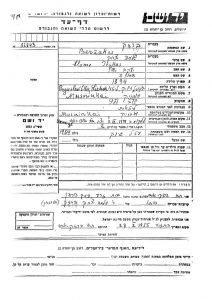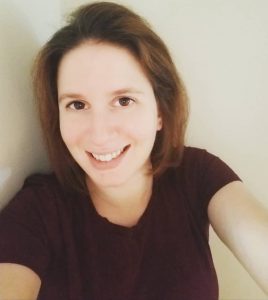I recently had the chance to sit down and chat with Dr. Adina, founder and owner of My Family Genie. Dr. Adina, a member of the International Society of Genetic Genealogy, GeneaBloggersTRIBE and the Virtual Genealogy Association, uses her doctoral level research and analytical skills to build family trees, uncover missing or previously undiscovered records, and find lost and unknown family members with the ultimate goal of connecting her clients to their past, present and future. In this article, Dr. Adina explains some of the aspects of Jewish genealogical research to us, delving into the intricacies of DNA and providing tips on helpful websites and overcoming brick walls in genealogy research. Even if you don’t have Jewish ancestors, no worries – many of her tips can apply to a variety of backgrounds!
Dr. Adina, My Family Genie
1. Hi Dr. Adina! Thank you for talking with us today. Can you tell us a little about your business to get us started?
Hello! Sure, no problem. As a genealogist, I use both traditional and genetic genealogy in my research. My most popular services have included helping people find records to overcome brick walls and making sense of DNA results. Besides looking into the past, I’m also pretty adept at using social media to locate living people, which especially helps in NPE (non-paternal event) or adoptee situations.
2. I see you specialize in Jewish genealogy. How did you get involved in that field in particular?
By default! I am fully Ashkenazi Jewish, so in order to understand my own genealogy, I needed to learn necessary skills and strategies related to Jewish genealogy. In my own search, I uncovered several resources that now allow me to help others in their pursuit to understand their own Jewish roots.
3. That sounds really interesting. Could you explain to us a bit how history has affected Jewish genealogy, in addition to the more obvious World War II?
For one, Jewish surnames are a fairly new phenomenon. Historically, Jews went by the “son of” or “daughter of”, and this is still reflected in religious practices and on Jewish graves. Although some German Jews adopted surnames as early as the 17th century, Eastern Europe did so much later; the Austro-Hungarian Empire began in the late 18th century. Parent/child and siblings may have had different surnames, especially when coupled with assimilation, which adds to the obstacles. In one example, family lore states that my great-grandfather purchased his surname to escape the Czar’s army. His brother adopted his wife’s surname. Recently discovered grandchildren of this brother’s line had no idea their grandfather had taken their grandmother’s surname, so they were shocked to learn that they had incorrectly been researching their grandfather’s line for years. Researching Y-DNA can also be particularly difficult because even relatively close matches according to genetic distance will have completely different surnames.
Additionally, due to worsening conditions and hope for a better life, major Jewish emigration from Eastern Europe and Germany occurred in the late 19th to early 20th centuries, so fairly recently. Families lost touch and were scattered throughout the world. As an example, I have found family members who immigrated to areas all around the United States, Canada, Uruguay, Argentina, UK, Soviet Russia, and Israel.
 My great-grandparents; They were first cousins that went by the name Michelson. The name was changed from Stikan (although the story goes that my great-grandfather was the one who purchased the Michelson last name to escape the Czar’s army, his uncle/father-in-law adopted the name when he came to the U.S.)
My great-grandparents; They were first cousins that went by the name Michelson. The name was changed from Stikan (although the story goes that my great-grandfather was the one who purchased the Michelson last name to escape the Czar’s army, his uncle/father-in-law adopted the name when he came to the U.S.)
4. You mentioned DNA. How is Jewish DNA unique? And how does that affect genealogists who are searching for their Jewish ancestors?
Jews are an endogamous population, which means they married within their own group. In the case of Ashkenazi Jews, we have thousands of DNA matches, most being distant and untraceable after centuries of endogamy and pedigree collapse. Any match past second cousins needs to be explored with additional scrutiny. This contributes to making the search for Jewish relatives overwhelming and more difficult than standard genetic genealogy research.
5. That does sound complicated. What one piece of advice would you give to the beginning genealogist looking for their Jewish ancestors?
Upload your DNA everywhere. Not just for ethnicity estimates, but also for more opportunities to find matches to build your family tree. AncestryDNA is the best place to start because it has the largest database. You can also upload your raw DNA data to gedmatch, Family Tree DNA, and MyHeritage. The 23andme V5 chip isn’t compatible with most sites (although MyHeritage just recently began accepting transfers), but it does have the second largest database.
A MyHeritage match with a found 2c1r. Notice the largest segment. I look at this first to determine whether a match is likely traceable. Although I don’t have matches that high that I haven’t solved, I have several starting around the 130cM mark that are comprised of smaller segments I am unable to trace.
 An AncestryDNA match with my known 2nd cousin. Elevated cMs are an example of how endogamy can affect your matches, although it usually becomes more of an issue further out.
An AncestryDNA match with my known 2nd cousin. Elevated cMs are an example of how endogamy can affect your matches, although it usually becomes more of an issue further out.
6. Good to know! What about more advanced genealogists? What would you tell them?
When looking at Jewish matches, sort by largest segment (sections of DNA that are identical between two individuals), not total cMs (units to measure genetic distance). If you have significant Ashkenazi DNA and thousands of matches, focus on those that are a total of at least 100cMs, a longest segment of at least 23cMs, and preferably 1 or 2 more that are 10-20cMs or longer.
7. What are three of your favorite online genealogy tools?
1. Ancestry.com – (Mostly AncestryDNA; I check matches daily!)
2. Familysearch.org – Best central repository for records, including many in Eastern Europe and New York City (the latter where many Jews at least started out when they immigrated to the U.S.).
3. DNA Detectives group on Facebook. Great place to learn about how to dissect DNA matches.
8. Are there any resources specific for Jewish genealogy that you’d recommend?
It depends on the country, but Jewishgen.org is the go-to (and also my actual favorite online genealogy tool), with thousands of records related to the Jewish world (many available to view on FamilySearch). The Central Database of Shoah Victims’ names through Yad Vashem has provided me with a plethora of information about my family who perished in the Holocaust. A page of testimony on the murder of my great-grandfather’s half-brother, found in the Central Database of Shoah Victims’ Names
A page of testimony on the murder of my great-grandfather’s half-brother, found in the Central Database of Shoah Victims’ Names
9. If one of your clients hits a brick wall, what tips and tricks do you have for them?
What I’ve found is that usually a client is trying to conquer too much at one time. Genealogy is a marathon. I always ask a client exactly what they want to find, which focuses the research and makes it less overwhelming. I had one client who was trying to find more information about an ancestor, but couldn’t find him in a ship manifest. Knowing that Ancestry can be finicky with spellings, I tried certain variations and uncovered the record, which helped her overcome the brick wall.
Genealogy also isn’t a solitary activity. Speaking with other relatives or encouraging them to take DNA tests can only provide more information to overcome any brick walls.


